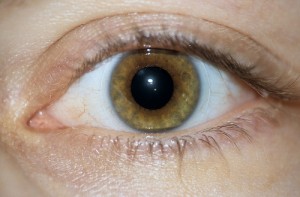Normally, the Official Google Blog posts advertisements on the latest company developments and information on research that is far from scientific. On January 16th 2014, however, an Official Google Blog post was released revealing information on a new project in development at the mysterious and secretive Google[x] facility. The project is certainly intriguing for the scientific community, but even more so than that the content and use of the blog itself clearly communicates in a way that readily engages the general public.
First, a little bit on the project itself: Researchers at the Google[x] facility are creating a contact lens that can measure the levels of glucose in diabetics. Scientists in the past have claimed that tears can provide very accurate readings of glucose levels, but have not found collecting tears to be an easy or enjoyable experience. The new smart contact lens uses a chip and a sensor embedded within the lens itself to detect glucose levels in tears and transmit them to the wearer. The chip and sensor are well hidden, as they are a very small part of the contact lens that is barely visible itself. There has also been some discussion of incorporating LED lights into the system that can indicate to the wearer when his or her glucose levels are too high or too low.

A contact lens is barely visible within an eye. Image Source: Flickr Commons.
Now, how does it generate the public’s interest?: The Official Google Blog post covering this project does an excellent job at pointing out to the public just what the development of this product could mean to them. It starts out by engaging those affected by diabetes by describing at least half a dozen unpleasant truths that diabetics can attest to. It also engages those not affected by diabetes by pulling at their heartstrings as they read about the struggles of being a diabetic, explaining the harsh procedure of having to prick one’s finger for a glucose level measurement and the inconvenience of fluctuating glucose levels which “change frequently with normal activity like exercising or eating or even sweating”. More importantly, the post

The painful, routine prick. Image Source: Flickr Commons.
quickly points out the severity of inconsistent glucose level monitoring. It provides the public with a perhaps relatable story from a concerned friend whose mother has a higher chance of passing out at inopportune times because of low glucose levels. Not to mention (which it does) the long-term effects of neglecting proper glucose levels, “including damage to the eyes, kidneys and heart”. The blog thus effectively demonstrates the importance of regulating glucose levels in diabetics.
The use of the blog itself is crafty on Google’s part, as it is concise and easy to understand, not being burdened with technical jargon. With the importance of tracking glucose levels in diabetics clearly established, readers find themselves thinking, “if only there was an easier way to do so…” and thus the blog successfully stimulates the intrigue of the smart contact lens.
-Maria Bernard
Further reading:
http://www.cbc.ca/news/technology/google-contact-lens-could-help-diabetics-track-glucose-1.2500274
http://www.summitmedicalgroup.com/library/adult_health/aha_self_glucose_monitoring/

